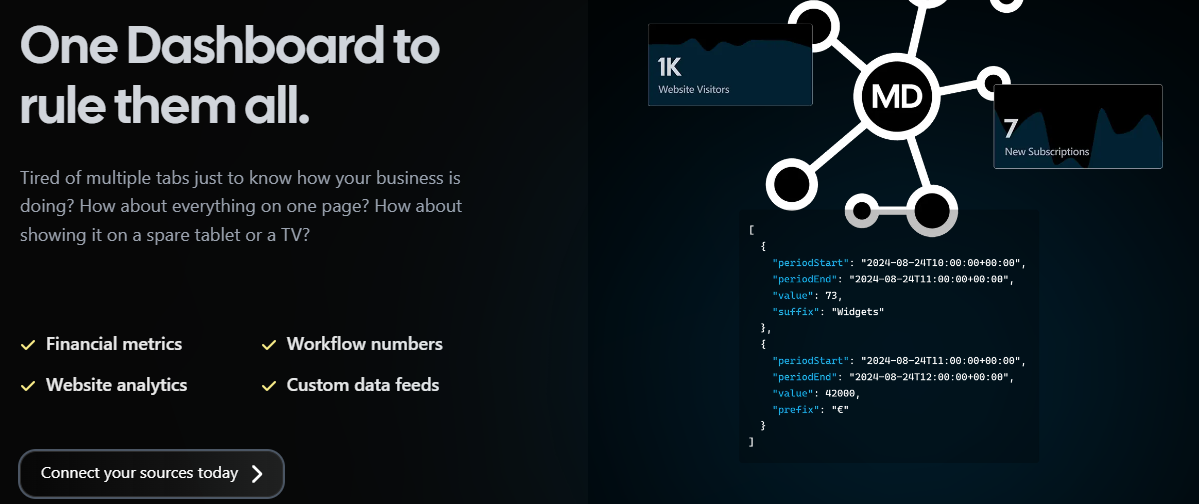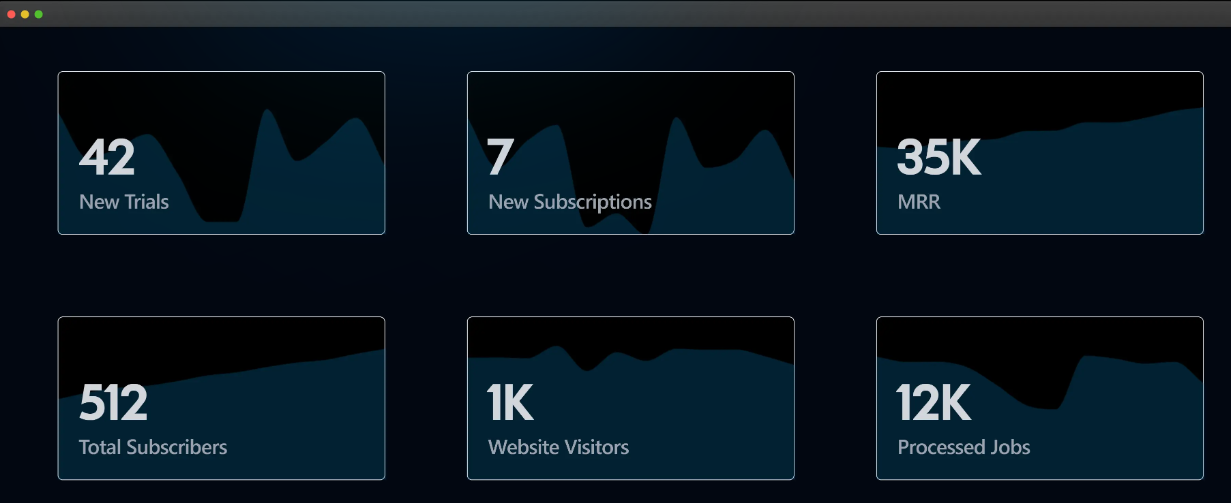What we cover in this article
Explore the key differences between KPIs and OKRs and their impact on business growth. Learn how combining these frameworks can drive success by tracking performance metrics and setting ambitious goals. With Minimal Dashboard, businesses can seamlessly monitor KPIs and OKRs, aligning teams for optimal performance and impactful outcomes.
Contents
- Introduction
- Not Sure of the Difference Between KPI & OKR?
- Why Listen to Us?
- KPI vs OKR: Overview
- What is KPI?
- What is OKR?
- 5 Key Differences Between KPI and OKR
- Can KPIs and OKRs Work Together?
- Visualize All Your KPIs and OKRs With Minimal Dashboard
Introduction
This article explores the key differences between KPI and OKR, analyzing how each framework helps organizations measure progress and achieve success. It breaks down what KPIs and OKRs mean, how they contribute to business growth, and how using them together can drive impactful outcomes. By leveraging Minimal Dashboard, businesses can easily track KPIs, set actionable OKRs, and align their teams for optimal performance, all from one intuitive platform.
Not Sure of the Difference Between KPI & OKR?
Understanding your organization’s progress is necessary for staying on track and achieving goals. Yet, with so many different performance metrics available, it is overwhelming to figure out which ones will truly drive growth and improvement.
Both KPIs (Key Performance Indicators) and OKRs (Objectives and Key Results) play critical roles in measuring success and pushing the right changes forward. But how do these two approaches differ, and do you need both?
In this article, we will break down the key differences between the KPI and OKR framework and how they affect business growth.
But first…
Why Listen to Us?
At Minimal Dashboard, we empower businesses by offering a comprehensive solution for tracking both KPIs and OKR in a single, unified platform. Our system effortlessly integrates into existing workflows, providing instant visibility for business teams. With real-time alerts for unusual changes, you can quickly identify and address any performance issues.

KPI vs OKR: Overview
Aspect |
KPIs (Key Performance Indicators) |
OKRs (Objectives and Key Results) |
Definition |
Measurable values showing progress toward long-term business goals. |
A goal-setting framework that defines objectives and measurable key results. |
Purpose |
Track ongoing performance in specific areas. |
Drive teams toward ambitious, short-term goals. |
Focus |
Specific, quantifiable outcomes like revenue or customer growth. |
High-level objectives with defined key results. |
Duration |
Long-term, continuous measurement. |
Short-term, goal-oriented progress. |
Approach |
Monitor steady progress. |
Encourages stretching and innovation. |
What is KPI?
Key Performance Indicators (KPIs) are metrics used to assess the effectiveness and progress of an organization, project, or individual over a given period. They help track performance in relation to set targets, allowing for a clearer understanding of what’s working and what needs improvement.
KPIs should ideally align with strategic objectives, indicating where resources should be concentrated. For them to be truly effective, KPIs should be measurable, with quantifiable data making it easier to assess performance and make comparisons.
While qualitative KPIs are possible, they often create ambiguity and lead to subjective conclusions, diluting their effectiveness.
1. KPI Examples
KPIs can vary greatly across industries and departments. They offer a way to quantify progress and gauge success in reaching goals. Each department within an organization can have its own KPIs to ensure objectives are met efficiently.
Here are some examples of KPIs for different industries and divisions:
- Sales Department: Lead conversion rate, average deal size, revenue growth
- HR Department: Employee turnover rate, job satisfaction score, training completion rate
- Retail Industry: Sales per employee, customer conversion rate, gross profit margin
- Healthcare Industry: Patient satisfaction score, hospital readmission rate, treatment success rate
- Technology Industry: Customer acquisition cost, system uptime, feature adoption rate
Intuitive platforms like Minimal Dashboard offer comprehensive tracking for all your major KPIs. With instant visibility, automated updates, and relevant notifications, we ensure that every KPI stays on your radar, giving you the data you need to make informed decisions before it’s too late.

What is OKR?
OKR stands for Objectives and Key Results, a strategic goal-setting framework that ties measurable outcomes to clear objectives. While KPIs measure performance within a given framework, OKRs are used to define the framework itself, offering a more structured approach to achieving ambitious goals.
OKRs rely on specific, measurable metrics to track progress toward objectives. Typically, organizations define three to five high-level objectives, with three to five measurable key results for each objective.
The key results are usually evaluated on a numeric scale, such as 0-1 or 0-100, providing a transparent measure of progress. OKRs are designed to be quantifiable, time-bound, and ambitious, pushing teams to aim for challenging, but achievable, goals.
1. OKR Examples
OKRs inspire growth and improvement by focusing on bold, overarching objectives that drive organizations forward. These goals should feel ambitious and almost out of reach to challenge both teams and individuals.
Here are some practical examples of OKRs:
Objective: Enhance product engagement
- Key result 1: Extend the average session duration from 15 to 30 minutes.
- Key result 2: Evaluate competitors’ features and integrate three top improvements.
- Key result 3: Boost daily user activity by 17%.
Objective: Strengthen brand credibility through social proof
- Key result 1: Achieve 33,000 views on the testimonials page.
- Key result 2: Increase click-through rates in the outreach campaign to 19%.
- Key result 3: Raise LinkedIn shares from 50 to 120.
- Key result 4: Decrease customer acquisition cost from $100 to $45.
Objective: Personalize sales strategy to improve lead nurturing
- Key result 1: Increase the number of lead touchpoints from 3 to 7.
- Key result 2: Improve email follow-up open rates from 15% to 38%.
- Key result 3: Achieve an 8.5/10 average customer satisfaction score from 150 survey responses.
With Minimal Dashboard, tracking OKRs becomes a straightforward process. Our interactive dashboards enable businesses to set, monitor, and visualize their objectives and key results in one place. By integrating data from various sources, Minimal Dashboard helps teams stay aligned with their goals, fostering transparency and accountability.
![]()
5 Key Differences Between KPI and OKR
1. Purpose
- KPI: KPIs serve to monitor ongoing business performance. For instance, a company may track its monthly website traffic to ensure marketing efforts are maintaining a steady flow of visitors. If the KPI shows a dip, this signals that something needs adjusting in the marketing strategy.
- OKR: OKRs are goal-oriented and push the organization toward a specific achievement. For example, an OKR might aim to increase website traffic by 20% within the next quarter through targeted campaigns. This objective provides a clear direction and calls for strategic action to achieve a measurable improvement.
2. Focus and Scope
- KPI: KPIs are typically centered on everyday business operations. For instance, using a metrics tool like Minimal Dashboard, KPI for a retail store will track the average sales per employee, ensuring that staff performance meets established standards. If the numbers drop, management knows where to focus resources.
- OKR: OKRs, in contrast, are broader and more aspirational. A retail store might set an OKR to increase sales per employee by 10% in the next six months by implementing new training programs and sales strategies. The OKR pushes the team to tune up performance beyond the usual targets.
3. Measurement and Evaluation
- KPI: KPIs are measured regularly and provide insight into steady performance. A software company, for example, may track its customer retention rate as a KPI. If retention stays high, it indicates that the company’s product meets customer needs.
- OKR: OKRs use key results to evaluate progress toward ambitious goals. The same software company might create an OKR to improve customer retention by 15% over the next year by enhancing customer support and launching new features. Key results would track specific milestones like reducing response times and launching customer satisfaction surveys.
4. Motivation and Ambition
- KPI: KPIs tend to focus on maintaining consistent performance. A KPI for an HR department might measure the average recruitment time to ensure hiring processes are efficient. The goal is to meet the current industry standard and keep operations running smoothly.
- OKR: OKRs, on the other hand, are designed to challenge teams. An HR department could set an OKR to reduce average recruitment time by 30% in the next quarter by shortening interview times and introducing automated hiring tools. This ambitious goal encourages innovation and a proactive approach.
5. Process
- KPI: KPIs are standalone metrics with no embedded improvement process. For example, a KPI might measure a company’s monthly sales revenue, offering a snapshot of performance without providing insight into how to improve those numbers.
- OKR: OKRs follow a structured process that promotes continuous progress. A company might set an OKR to increase sales revenue by 20% through new marketing strategies and product launches. The process involves regular check-ins and adjustments to stay aligned with the overall business goals.
Can KPIs and OKRs Work Together?
Absolutely. Their full potential is realized when they complement each other. KPIs help track performance metrics, while OKRs provide a framework to drive improvement and achieve ambitious goals. Used in tandem, they create a balanced system for both monitoring ongoing performance and pushing the business toward future success.
Let’s consider a scenario where both KPIs and OKRs are utilized together:
A retail company has set a KPI to keep customer churn below 5% over the next year. However, after a quarterly review, they find the current churn rate is 8%, signaling an area that requires attention. In response, the company sets an OKR to reduce churn by improving customer engagement and service.
For example:
- Objective: Reduce customer churn by improving customer satisfaction.
- Key Result 1: Launch a customer loyalty program and enroll 50% of active customers within the next three months.
- Key Result 2: Increase customer support response rates by 30%.
- Key Result 3: Achieve a customer satisfaction rating of 90% or higher in post-service surveys.
In this case, the KPI (customer churn rate) measures overall performance, while the OKR (reducing churn) drives the specific actions needed to improve that metric. The OKR breaks down the steps needed to address the issue highlighted by the KPI, enabling the company to take focused action to achieve its broader business goals.
Visualize All Your KPIs and OKRs With Minimal Dashboard
OKRs and KPIs are powerful tools for tracking progress and pushing your organization toward greater success. When implemented effectively, they can create a shared sense of purpose that keeps everyone aligned with the company’s broader objectives.
For businesses seeking a dynamic way to track and manage these critical metrics, Minimal Dashboard offers an outstanding solution. With its user-friendly interface, you can easily monitor KPIs and set OKRs, ensuring that your entire team has visibility into performance data and actionable objectives. Minimal Dashboard simplifies keeping initiatives on track, making it easier to manage progress and stay aligned.
Ready to take control of your organization’s growth? Sign up for Minimal Dashboard today.
